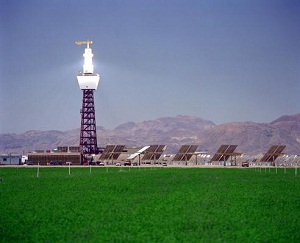Ken Salazar signs off on new SolarReserve solar thermal plant
 SolarReserve’s 110 megawatt Crescent Dunes Solar Energy Project, near Tonopah, Nev., got an important nod from the Department of the Interior (DOI) last month when Interior Secretary Ken Salazar approved the project.
SolarReserve’s 110 megawatt Crescent Dunes Solar Energy Project, near Tonopah, Nev., got an important nod from the Department of the Interior (DOI) last month when Interior Secretary Ken Salazar approved the project.
Despite some other outstanding permits, the company is on target to start construction on the project in 2011.
While some large-scale solar thermal projects are experiencing difficulty gaining financing or breaking ground, like Tessera Solar’s projects, SolarReserve has not experienced such issues, said SolarReserve spokesperson Andi Plocek.
“We’re definitely going on schedule,” she said. “The technologies are very different, and we’re very lucky that we had the project Solar 2 to show [the technologies].”
She said the success of Solar 2 is making it easier to gain financing for SolarReserves’ solar thermal projects.
The company now is in the process of getting a loan guarantee from the Department of Energy for Crescent Dune and other projects, according to the DOI. Both the approval of the facility and the fact that SolarReserve has signed a power purchase agreement with NV Energy should help it get the loan guarantee and subsequent financing.
The molten salt-based thermal solar tower SolarReserve plans to build includes thermal storage. The thermal storage allows the system to generate electricity for up to eight hours after dark and during cloudy periods of the day. The tower and the storage were tested in the 1990s at Solar 2, an installation in California, Plocek said. The technology was originally developed by Pratt & Whitney Rocketdyne.
Crescent Dunes is the ninth large-scale solar energy project that the DOI has signed off on, according to a department press release.
“Crescent Dunes joins a host of renewable energy projects on public lands in the West that are opening a new chapter on how our nation is powered,” Salazar said upon signing the Record of Decision. He added that the Crescent Dunes and other solar projects on public lands will increase the country’s energy security, create jobs and stimulate the local economy.
The proposed project is sited on approximately 2,250 acres under the jurisdiction of the Bureau of Land Management.
“That was our big decision from the Department of the Interior to build on the land,” Plocek said. “We still have a couple of permits left.” The outstanding permits are relatively small matters. She added, “But they’re there.”
Pictured: Solar 2, the predecessor of SolarReserve's projects, courtesy of NREL.



